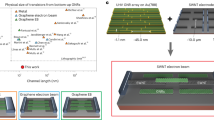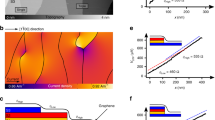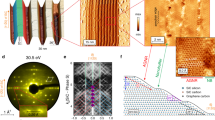Abstract
Graphene nanoribbons will be essential components in future graphene nanoelectronics1. However, in typical nanoribbons produced from lithographically patterned exfoliated graphene, the charge carriers travel only about ten nanometres between scattering events, resulting in minimum sheet resistances of about one kilohm per square2,3,4,5. Here we show that 40-nanometre-wide graphene nanoribbons epitaxially grown on silicon carbide6,7 are single-channel room-temperature ballistic conductors on a length scale greater than ten micrometres, which is similar to the performance of metallic carbon nanotubes. This is equivalent to sheet resistances below 1 ohm per square, surpassing theoretical predictions for perfect graphene8 by at least an order of magnitude. In neutral graphene ribbons, we show that transport is dominated by two modes. One is ballistic and temperature independent; the other is thermally activated. Transport is protected from back-scattering, possibly reflecting ground-state properties of neutral graphene. At room temperature, the resistance of both modes is found to increase abruptly at a particular length—the ballistic mode at 16 micrometres and the other at 160 nanometres. Our epitaxial graphene nanoribbons will be important not only in fundamental science, but also—because they can be readily produced in thousands—in advanced nanoelectronics, which can make use of their room-temperature ballistic transport properties.
This is a preview of subscription content, access via your institution
Access options
Subscribe to this journal
Receive 51 print issues and online access
$199.00 per year
only $3.90 per issue
Buy this article
- Purchase on Springer Link
- Instant access to full article PDF
Prices may be subject to local taxes which are calculated during checkout





Similar content being viewed by others
References
Berger, C. et al. Ultrathin epitaxial graphite: 2D electron gas properties and a route toward graphene-based nanoelectronics. J. Phys. Chem. B 108, 19912–19916 (2004)
Han, M. Y. Özyilmaz, B. Zhang, Y. & Kim, P. Energy band-gap engineering of graphene nanoribbons. Phys. Rev. Lett. 98, 206805 (2007)
Han, M. Y., Brant, J. C. & Kim, P. Electron transport in disordered graphene nanoribbons. Phys. Rev. Lett. 104, 056801 (2010)
Chen, Z. H., Lin, Y. M., Rooks, M. J. & Avouris, P. Graphene nano-ribbon electronics. Physica E 40, 228–232 (2007)
Todd, K., Chou, H. T., Amasha, S. & Goldhaber-Gordon, D. Quantum dot behavior in graphene nanoconstrictions. Nano Lett. 9, 416–421 (2009)
Sprinkle, M. et al. Scalable templated growth of graphene nanoribbons on SiC. Nature Nanotechnol. 5, 727–731 (2010)
Ruan, M. Structured Epitaxial Graphene for Electronics. PhD thesis, Georgia Inst. Technol. (2012); available at http://hdl.handle.net/1853/45596
Castro Neto, A. H., Guinea, F., Peres, N. M. R., Novoselov, K. S. & Geim, A. K. The electronic properties of graphene. Rev. Mod. Phys. 81, 109–162 (2009)
Berger, C. et al. Electronic confinement and coherence in patterned epitaxial graphene. Science 312, 1191–1196 (2006)
Datta, S. Electronic Transport in Mesoscopic Systems (Cambridge Univ. Press, 1995)
Nakada, K., Fujita, M., Dresselhaus, G. & Dresselhaus, M. S. Edge state in graphene ribbons: nanometer size effect and edge shape dependence. Phys. Rev. B 54, 17954–17961 (1996)
Wakabayashi, K., Takane, Y. & Sigrist, M. Perfectly conducting channel and universality crossover in disordered graphene nanoribbons. Phys. Rev. Lett. 99, 036601 (2007)
Frank, S., Poncharal, P., Wang, Z. L. & de Heer, W. A. Carbon nanotube quantum resistors. Science 280, 1744–1746 (1998)
de Heer, W. A. et al. Large area and structured epitaxial graphene produced by confinement controlled sublimation of silicon carbide. Proc. Natl Acad. Sci. 108, 16900–16905 (2011)
Hu, Y. et al. Structured epitaxial graphene: growth and properties. J. Phys D 45, 154010 (2012)
Hicks, J. et al. A wide-bandgap metal–semiconductor–metal nanostructure made entirely from graphene. Nature Phys. 9, 49–54 (2013)
Norimatsu, W. & Kusunoki, M. Formation process of graphene on SiC (0001). Physica E 42, 691–694 (2010)
Büttiker, M. Four terminal phase coherent conductance. Phys. Rev. Lett. 57, 1761–1764 (1986)
de Picciotto, R., Stormer, H. L., Pfeiffer, L. N., Baldwin, K. W. & West, K. W. Four-terminal resistance of a ballistic quantum wire. Nature 411, 51–54 (2001)
Tombros, N. et al. Quantized conductance of a suspended graphene nanoconstriction. Nature Phys. 7, 697–700 (2011)
Huard, B. et al. Transport measurements across a tunable potential barrier in graphene. Phys. Rev. Lett. 98, 236803 (2007)
Mott, N. F. Conduction in non-crystalline materials. III. Localized states in a pseudogap and near extremities of conduction and valence bands. Phil. Mag. 19, 835–852 (1969)
Schonenberger, C., Bachtold, A., Strunk, C., Salvetat J. P & Forro, L. Interference and interaction in multi-wall carbon nanotubes. Appl. Phys. A 69, 283–295 (1999)
Das Sarma, S., Adam, S., Hwang, E. H. & Rossi, E. Electronic transport in two-dimensional graphene. Rev. Mod. Phys. 83, 407–470 (2011)
Chen, J. H., Jang, C., Xiao, S. D., Ishigami, M. & Fuhrer, M. S. Intrinsic and extrinsic performance limits of graphene devices on SiO2 . Nature Nanotechnol. 3, 206–209 (2008)
Mayorov, A. S. et al. Micrometer-scale ballistic transport in encapsulated graphene at room temperature. Nano Lett. 11, 2396–2399 (2011)
Huard, B., Stander, N., Sulpizio, J. A. & Goldhaber-Gordon, D. Evidence of the role of contacts on the observed electron-hole asymmetry in graphene. Phys. Rev. B 78, 121402R (2008)
Lemme, M., Echtermeyer, T. J., Baus, M. & Kurz, H. A graphene field effect device. IEEE Electron Device Lett. 28, 282–284 (2007)
Lin, Y. M., Perebeinos, V., Chen, Z. H. & Avouris, P. Electrical observation of subband formation in graphene nanoribbons. Phys Rev B 78, 161409(R) (2008)
Wang, X. R. et al. Graphene nanoribbons with smooth edges behave as quantum wires. Nature Nanotechnol. 6, 563–567 (2011)
Acknowledgements
C.T. thanks the German Research Foundation Priority Program 1459 ‘Graphene’ for financial support. C.B., E.H.C. and W.A.d.H. thank R. Dong, P. Goldbart, Z. Guo, J. Hankinson, J. Hicks, Y. Hu, J. Kunc, M. Kindermann, D. Mayou, M. Nevius, J. Palmer, A. Sidorov and P. de Heer for assistance and comments. C.B., E.H.C. and W.A.d.H. thank the AFOSR, NSF (MRSEC – DMR 0820382), W. M. Keck Foundation and Partner University Fund for financial support. Work at ORNL was supported by the Scientific User Facilities Division, BES of the DOE.
Author information
Authors and Affiliations
Contributions
J.B. and F.E. produced samples and performed the in situ transport experiments in Hannover relating to Fig. 3. C.T. performed and supervised the transport experiments in Fig. 3, discussed the data and commented on the paper. M.R. produced the samples and performed transport experiments shown in Fig. 4 and Supplementary Figs 3–6. E.H.C., A.T. and A.T.-I. performed ARPES experiments, and A.T. and M.S. the STM and STS experiments. Z.J. performed confirming spin transport measurements and contributed to C-AFM results shown in Supplementary Fig. 6b. A.-P.L. performed earlier SPM measurements. W.A.d.H. conceived and supervised the experiment and interpreted the data. C.B. supervised and performed the Atlanta based experiments. W.A.d.H. and C.B. wrote the paper.
Corresponding author
Ethics declarations
Competing interests
The authors declare no competing financial interests.
Supplementary information
Supplementary Information
This file contains Supplementary Text, Supplementary Figures 1-12, Supplementary Table 1 and Supplementary References. (PDF 4427 kb)
Rights and permissions
About this article
Cite this article
Baringhaus, J., Ruan, M., Edler, F. et al. Exceptional ballistic transport in epitaxial graphene nanoribbons. Nature 506, 349–354 (2014). https://doi.org/10.1038/nature12952
Received:
Accepted:
Published:
Issue Date:
DOI: https://doi.org/10.1038/nature12952
This article is cited by
-
Atomic-scale manipulation of buried graphene–silicon carbide interface by local electric field
Communications Physics (2024)
-
Simple and Harmless Fabrication of Reduced Graphene Oxide-Based Transparent Conductive Film Using L-Ascorbic Acid as Reducing Agent
Arabian Journal for Science and Engineering (2024)
-
Tunable growth of one-dimensional graphitic materials: graphene nanoribbons, carbon nanotubes, and nanoribbon/nanotube junctions
Scientific Reports (2023)
-
Relativistic domain-wall dynamics in van der Waals antiferromagnet MnPS3
npj Computational Materials (2022)
-
Graphene nanoribbons initiated from molecularly derived seeds
Nature Communications (2022)
Comments
By submitting a comment you agree to abide by our Terms and Community Guidelines. If you find something abusive or that does not comply with our terms or guidelines please flag it as inappropriate.



